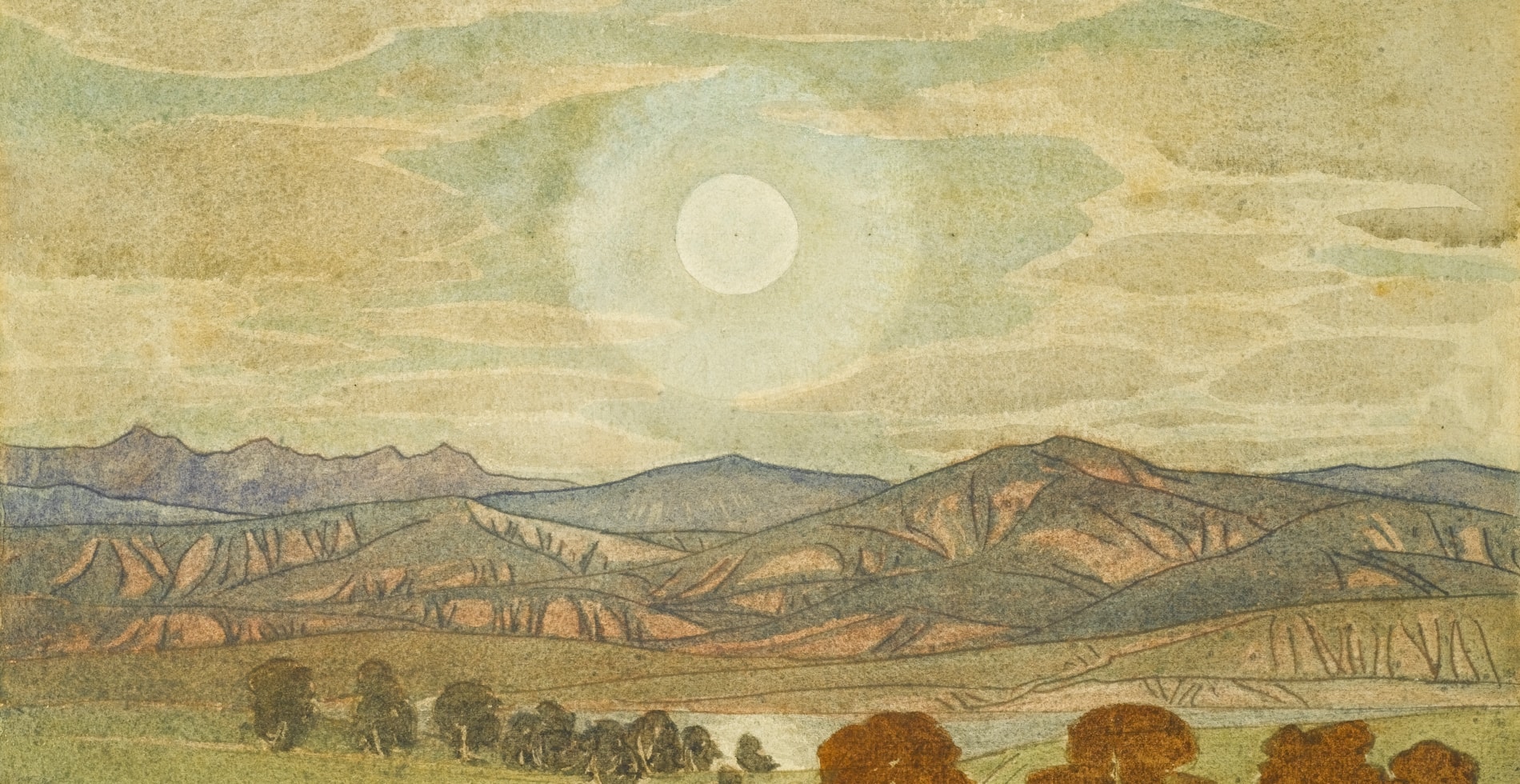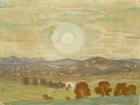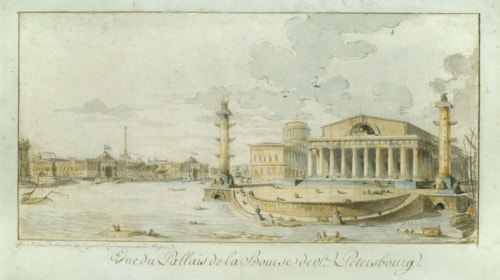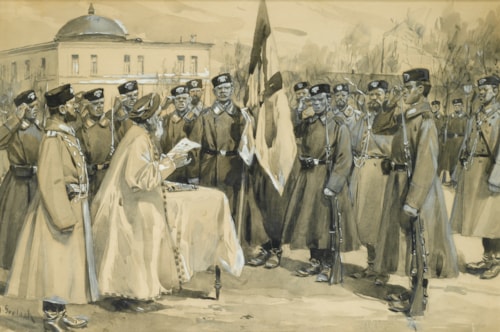aksimilian Aleksandrovich Voloshin
(Kiev 1877 - Koktebel 1932)
Koktebel at Dusk
with an indistinct dedication in Russian; signed in Cyrillic, inscribed and dated 'Koktebel'/1918' (lower right)
pencil, watercolour and ink on paper
26 x 34.7 cm (10¼ x 13½ in)
Maksimilian Aleksandrovich Voloshin’s Koktebel at Dusk evokes a sense of calm which pervades the work. The rippled plains of Koktebel are marked with pencil, their skin-like folds adding an almost life-like quality to the landscape, as the mountainous expanse seems to heave a deep sigh. Above, the sun in all its glory casts a spherical, hazy light, the reflection of which is caught in the expanse of water below. The poetic nature and prominence given to the circular sun recalls the work of Vincent van Gogh (1853-1890), in the way that it dominates and ripples outwards, as well as the work of Voloshin’s contemporary Nikolai Konstantinovich Roerich.
The serenity of the scene is enhanced by the artist’s use of a restrained palette of blue, brown and green hues. The free, fluid movement of the artist’s hand, and the apparent ease with which he delineates his forms, underline Voloshin’s deep spiritual connection with Koktebel.
Koktebel, formerly known as Planerskoye, lies in southeastern Crimea, and is an area where Voloshin spent much of his childhood. Derived from the words töbe, meaning ‘hill’ or ‘mountain’, and kök, meaning ‘sky blue’, the origins of the name Koktebel, ‘Land of the blue hills’, are Turkic. Koktebel featured prominently in Voloshin’s poetry and art, with his first collection of verse, published in 1910, containing over a dozen poems dedicated to the area. In addition to many watercolours, such as the present work, Voloshin devoted some sixty poems to this corner of the Crimea. ‘Never were a poet’s works so closely bound up with the place where he lived. He recreated the semi-mythical world of the Cimmerii in pictures and verses. He painted landscapes of primeval eastern Crimea. Nature itself seemed to respond to Voloshin’s art.’¹
Many of Voloshin’s landscapes of Koktebel were created from memory, becoming almost fantastical interpretations rather than exact reflections of the landscape. Voloshin created a mystical land, much like Roerich, and Konstantin Fyodorovich Bogaevsky (1872-1943). Voloshin was credited with launching the artistic career of Bogaevsky when he wrote a series of essays entitled Konstantin Bogaevsky, and stylistic comparisons are often made between the two artists.
One of the key representatives of Russian Symbolism, Voloshin was a poet, artist, philosopher and literary critic. His first collection of poetry appeared in 1910, and his collected essays were published in 1914. His poems were praised for their considerable historical observation, and drew on experiences from the First World War, the Russian Revolution and the ensuing Russian Civil War, appealing ‘in the days of revolutions to be a human, not a citizen... in the disturbances of wars to realize the oneness. To be not a part, but all: not from one side, but from both’.
During the latter years of his life, Voloshin accompanied his literary and philosophical studies with painting, and gained additional recognition as a subtle watercolourist, with depictions of Crimean landscapes, such as the present work, forming the majority of his artistic legacy.
¹ Sossinsky, S., ‘Keeping Aloof or Joining In the Fray’, in Moscow News, History; No.41, October 27, 1999.
Maksimilian Aleksandrovich Voloshin’s Koktebel at Dusk evokes a sense of calm which pervades the work. The rippled plains of Koktebel are marked with pencil, their skin-like folds adding an almost life-like quality to the landscape, as the mountainous expanse seems to heave a deep sigh. Above, the sun in all its glory casts a spherical, hazy light, the reflection of which is caught in the expanse of water below. The poetic nature and prominence given to the circular sun recalls the work of Vincent van Gogh (1853-1890), in the way that it dominates and ripples outwards, as well as the work of Voloshin’s contemporary Nikolai Konstantinovich Roerich.
The serenity of the scene is enhanced by the artist’s use of a restrained palette of blue, brown and green hues. The free, fluid movement of the artist’s hand, and the apparent ease with which he delineates his forms, underline Voloshin’s deep spiritual connection with Koktebel.
Koktebel, formerly known as Planerskoye, lies in southeastern Crimea, and is an area where Voloshin spent much of his childhood. Derived from the words töbe, meaning ‘hill’ or ‘mountain’, and kök, meaning ‘sky blue’, the origins of the name Koktebel, ‘Land of the blue hills’, are Turkic. Koktebel featured prominently in Voloshin’s poetry and art, with his first collection of verse, published in 1910, containing over a dozen poems dedicated to the area. In addition to many watercolours, such as the present work, Voloshin devoted some sixty poems to this corner of the Crimea. ‘Never were a poet’s works so closely bound up with the place where he lived. He recreated the semi-mythical world of the Cimmerii in pictures and verses. He painted landscapes of primeval eastern Crimea. Nature itself seemed to respond to Voloshin’s art.’¹
Many of Voloshin’s landscapes of Koktebel were created from memory, becoming almost fantastical interpretations rather than exact reflections of the landscape. Voloshin created a mystical land, much like Roerich, and Konstantin Fyodorovich Bogaevsky (1872-1943). Voloshin was credited with launching the artistic career of Bogaevsky when he wrote a series of essays entitled Konstantin Bogaevsky, and stylistic comparisons are often made between the two artists.
One of the key representatives of Russian Symbolism, Voloshin was a poet, artist, philosopher and literary critic. His first collection of poetry appeared in 1910, and his collected essays were published in 1914. His poems were praised for their considerable historical observation, and drew on experiences from the First World War, the Russian Revolution and the ensuing Russian Civil War, appealing ‘in the days of revolutions to be a human, not a citizen... in the disturbances of wars to realize the oneness. To be not a part, but all: not from one side, but from both’.
During the latter years of his life, Voloshin accompanied his literary and philosophical studies with painting, and gained additional recognition as a subtle watercolourist, with depictions of Crimean landscapes, such as the present work, forming the majority of his artistic legacy.
¹ Sossinsky, S., ‘Keeping Aloof or Joining In the Fray’, in Moscow News, History; No.41, October 27, 1999.





 contact
contact contact
contact +44 20 7313 8040
+44 20 7313 8040









